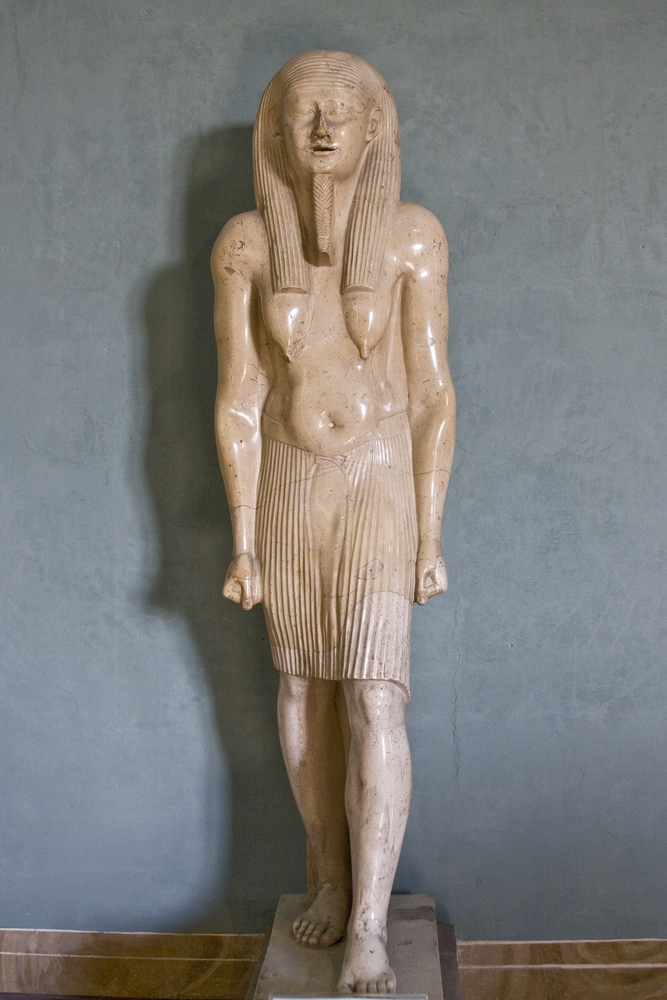
Many Christians in the West conceive of God as masculine, but this view isn’t universal. Several religious traditions venerate goddesses or multiple deities. Some modern Jewish thought suggests a supreme deity who surpasses gender. Divine beings that transcend gender aren’t a new idea, however. As you’ll see, history is full of non-binary, intersex, multi-gendered, and agender deities.
Hapi: The Nile God With Breasts
People sometimes use secondary sex characteristics to strictly define gender. A man with breasts may seem very strange to them, but it’s a reality that many transgender men live with daily. But what would they think of Hapi, an ancient Egyptian god of the Nile River?
At Ancient Egypt Online, historian Jenny Hill explains that Hapi was responsible for moving the waters of the Nile. Judging from written records, predynastic peoples in the region may have called the Nile River “Hapi.” That points to a solid link between the god and his river. Sometimes manifesting as the twin deities Hap-Reset and Hap-Meht, they’re often shown pouring water from jugs or tying together stalks of papyrus and lotus. At times, Hapi was also called “Lord of the Fishes and Birds of the Marshes.”
Hill describes Hapi based on surviving artwork. Depending on the artist, Hapi was depicted with either blue or green skin. This portly god also had large breasts and sported the same false beard as the pharaohs. In ancient Egyptian symbolism, his breasts and skin color signify his role as a fertility god. The false beard represents his link to the pharaohs.
Cybele: An Intersex Goddess
Being intersex is as common as having naturally red hair. According to the Intersex Campaign for Equality, intersex people comprise around 1.7% of the world’s population. That’s about 131 million individuals, equal to over a third of the current U.S. population. With these figures, it’s no surprise that some religious traditions venerate intersex deities.
Cybele is one such deity. Cybele was venerated in ancient Rome but first worshiped as the Greek goddess Agdistis. In the National Organization for Women’s LGBTime Machine series, Sabeau Rea tells part of Cybele’s story. Some texts describe Agdistis as multi-gendered, but the Phrygian Cybele was usually envisioned as feminine. Both goddesses could bear children and get others pregnant.
The Ancient History Encyclopedia mentions that Cybele was called “Magna Mater,” or Great Mother, by ancient Roman devotees. Her cult was very popular in Rome, and she was served by special clergy called the Gallae. They’re frequently described as eunuch priests, but other evidence suggests that they were transgender women. Rea describes individuals who dressed in Greek women’s traditional attire, wore makeup, and arranged their hair in feminine styles not just in the sacred sphere, but also when appearing in public.
Olodumare: The Agender Deity
How do you worship agender deities who don’t use pronouns? If it’s Olodumare, you refer to this supreme entity as “Almighty.” As part of traditional Yoruba religion, Olodumare is an all-encompassing entity whose existence defies gender itself, as well as gender expression. This being is imbued by “ashe,” a Yoruba term for the divine energy that produces our physical worlds and their inhabitants.
Black Perspectives calls the deity genderless or as “possessing all possible gender expressions simultaneously.” Writer James Padilioni Jr. adds that Olodumare is far beyond the realm of human understanding. Because of this, the orishas are needed to express and represent aspects of ashe. When Olodumare is referred with pronouns, devotees typically use “it” or “they.”
A World of Spiritual Diversity
Do we create the divine in our own image? If so, what does that say about non-binary, intersex, and agender deities from the past? Humans wrestle with this question in the twenty-first century. As cultures constructed their understanding of gender, they left many clues behind. If we examine these clues in today’s world, we find that maybe we’re not so different from our ancestors after all.

